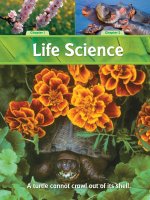2.1 All about plants (life science)
Bạn đang xem bản rút gọn của tài liệu. Xem và tải ngay bản đầy đủ của tài liệu tại đây (3 MB, 14 trang )
Life Science
Genre
Nonfiction
Comprehension Skill
Predict
Text Features
• Captions
• Labels
• Glossary
Science Content
Plants
Scott Foresman Science 2.1
by Leslie Ann Rotsky
ISBN 0-328-13769-3
ì<(sk$m)=bdhgjf< +^-Ä-U-Ä-U
Vocabulary
adapted
What didAll
you About
learn?
Plants
1. What are the four parts of a plant?
environment
2. What are
groups
of plants?
by two
Leslie
Ann
Rotsky
flower
3.
In this book you read
about ways plants are adapted to their
environments. Write to explain two of these
ways. Use words from the book as you write.
4.
Predict What would happen if you
put a plant in a very dark room without any
windows?
leaves
nutrients
prairie
roots
stem
Photographs: Every effort has been made to secure permission and provide appropriate credit for
photographic material. The publisher deeply regrets any omission and pledges to correct errors called to its
attention in subsequent editions. Unless otherwise acknowledged, all photographs are the property of Scott
Foresman, a division of Pearson Education. Photo locators denoted as follows: Top (T), Center (C), Bottom
(B), Left (L), Right (R) Background (Bkgd)
Title Page: ©DK Images 3 Corbis 4 (Bkgd, BL) ©DK Images 6 (CC) ©DK Images, (B) ©Michael Boys/
Corbis 7 (T) ©Ted Mead/PhotoLibrary, (CR) ©ChromaZone Images/Index Stock Imagery, (CR) ©DK
Images, (B) ©Scott Camazine/Photo Researchers, Inc. 8 (CC) Ted Levin/Animals Animals/Earth Scenes,
(R) Steve Kaufman/Corbis 10 (B) ©Bill Ross/Corbis, (TC) ©DK Images 11 (TR) Getty Images, (B) ©Ted
Mead/PhotoLibrary 12 (B) ©M.P. Kahl/DRK Photo 13 (R) Royalty-Free/Corbis, (CR) ©DK Images 15
(Bkgd) ©Bob Wickham/PhotoLibrary, (BR, TR) ©DK Images 17 (Bkgd) Getty Images, (TR) ©Pat O’Hara/
Corbis, (BR) ©David Muench/Corbis 19 (TR) Steve Kaufman/Corbis, (BR) Patti Murray/Animals Animals/
Earth Scenes, (Bkgd) Randall Hyman Photography 21 (BR) ©OSF/Animals Animals/Earth Scenes, (TR)
Image Quest 3-D/NHPA Limited, (Bkgd) ©David Muench 22 (TR) ©DK Images, (CC) Corbis, (B) Richard
Hamilton Smith/Corbis 23 (TR) ©Stephen Dalton/NHPA Limited, (B) David Middleton/NHPA Limited
ISBN: 0-328-13769-3
Copyright © Pearson Education, Inc.
All Rights Reserved. Printed in the United States of America. This publication is
protected by Copyright and permission should be obtained from the publisher prior
to any prohibited reproduction, storage in a retrieval system, or transmission in any
form by any means, electronic, mechanical, photocopying, recording, or likewise. For
information regarding permissions, write to: Permissions Department, Scott Foresman,
1900 East Lake Avenue, Glenview, Illinois 60025.
3 4 5 6 7 8 9 10 V010 13 12 11 10 09 08 07 06 05
What are the parts
of a plant?
Plants need water, air, and sun.
Plants need space.
Plants need nutrients.
Nutrients are the food that living things
need to grow.
Plants get nutrients from soil and water.
2
Plant Parts
Plants have four parts.
The parts are the roots, stem, leaves,
and flowers.
These parts help the plant get what it needs.
3
Roots grow into the soil.
Roots hold a plant in place.
Roots take water and nutrients from the
soil to the stem.
The stem takes water and nutrients to
the leaves.
The stem holds up the plant.
Leaves use sunlight, air, and water to
make food for the plant.
Many plants have flowers.
A flower makes seeds.
Seeds make new plants.
Leaves
Stem
Roots
Flower
Seeds
4
5
How are seeds scattered?
Plants grow from seeds.
When seeds are spread out, they have
room to grow.
Scatter means to spread out.
The fruits of a maple tree
look like wings. This shape
helps them scatter.
6
The fruits of a
water lily have
seeds. The fruits
float on water.
Fruits cover seeds.
Fruits keep seeds safe.
Fruits help scatter seeds.
Some fruits travel by air or water.
Some fruits get stuck on animals.
Animals carry seeds to new places.
Burrs are fruits. They
hook onto animals. This
dog will help scatter the
seeds in these burrs.
7
How are plants grouped?
One group of plants has flowers.
The other group of plants does not
have flowers.
Plants with flowers grow in many places.
They can grow in gardens, fields, or deserts.
Trees are plants.
Some trees have flowers.
Peach trees grow flowers.
The flowers make peaches.
Peaches are fruits.
Fruits cover peach seeds and keep
them safe.
A cactus grows in the desert.
It has flowers that make seeds.
New cactus plants grow from
the seeds.
8
9
Plants without Flowers
Some plants do not have flowers.
Some plants have cones.
The seeds grow inside the cones.
The cone opens and seeds fall out.
The seeds grow into new trees.
Pine trees have
cones with seeds.
10
Ferns do not have flowers.
Ferns do not make seeds.
Ferns have leaves, roots, and stems.
Ferns live in warm,
shady, wet places.
11
How are some woodland
plants adapted?
Living things have adapted, or changed,
to live in many places.
An environment is a place with living and
nonliving things.
Maple trees are adapted to warm summers
and cold winters.
Maple trees have big, flat leaves.
These leaves drop off in the fall.
This helps the tree store water for the winter.
A woodland is a kind of environment.
Pine trees are adapted to the cold.
12
13
Plants that Live Near Water
Some plants in a woodland environment
live near water.
These plants are adapted to live where
it is wet.
This red plant is called a cardinal plant.
Its roots are adapted to get nutrients
from wet soil.
Cardinal plant
14
The stinging nettle has
sharp hairs to help keep
it safe from animals that
want to eat it.
The fanwort is adapted
to live in water.
15
How are some prairie plants
adapted?
Many plants live in a prairie environment.
A prairie has lots of grass and few trees.
Many prairies have hot summers with
little rain.
Some prairie plants are adapted to
hold water.
This helps when it does not rain.
Goldenrod plants
have stiff stems and
leaves. This helps the
plants keep the water
they need to live.
16
Prairie smoke has fuzz that
traps air. The air helps the
plant hold water.
Prairie grasses have small
leaves that help hold water.
17
How are some desert plants
adapted?
Many deserts are sunny and hot all day.
Deserts can be cool at night.
Deserts get little rain.
Some desert plants are adapted to hold
water for a long time.
The saguaro cactus has a
long, thick stem. The stem
holds water.
Some leaves on a desert
almond stay out of the
sun. These leaves can
hold water in the plant.
The octopus tree has short
leaves and long spines.
The spines keep the plant
safe from animals that
want to eat it.
18
19
How are some marsh
plants adapted?
A marsh is a wet environment.
Many plants grow in a marsh.
The soil in a marsh may not
have many nutrients.
Plants in a marsh get nutrients
in other ways.
Cattails grow in wet
soil. They are adapted
to get nutrients from
water in the soil.
20
A sundew plant has hairs
that trap insects. The plant
gets some nutrients from
the insects.
A venus’s flytrap also
gets some nutrients from
insects.
21
Plants are adapted to their environments.
Plants live in many kinds of places.
22
Every plant needs food, water, air, and
sunlight to grow!
23
Vocabulary
Glossary
adapted
adapted
environment
flower
environment
leaves
flower
nutrients
prairie
leaves
roots
stem
nutrients
What did you learn?
changed to be able to live in a
certain environment
1. What are the four parts of a plant?
a kind of place with living and
nonliving things
3.
In this book you read
about ways plants are adapted to their
environments. Write to explain two of these
ways. Use words from the book as you write.
4.
Predict What would happen if you
put a plant in a very dark room without any
windows?
the part of a plant that makes
seeds or fruit
flat, green parts growing from
the stem of a plant
food that living things need to
grow
Photographs: Every effort has been made to secure permission and provide appropriate credit for
photographic material. The publisher deeply regrets any omission and pledges to correct errors called to its
attention in subsequent editions. Unless otherwise acknowledged, all photographs are the property of Scott
Foresman, a division of Pearson Education. Photo locators denoted as follows: Top (T), Center (C), Bottom
(B), Left (L), Right (R) Background (Bkgd)
Title Page: ©DK Images 3 Corbis 4 (Bkgd, BL) ©DK Images 6 (CC) ©DK Images, (B) ©Michael Boys/
Corbis 7 (T) ©Ted Mead/PhotoLibrary, (CR) ©ChromaZone Images/Index Stock Imagery, (CR) ©DK
Images, (B) ©Scott Camazine/Photo Researchers, Inc. 8 (CC) Ted Levin/Animals Animals/Earth Scenes,
(R) Steve Kaufman/Corbis 10 (B) ©Bill Ross/Corbis, (TC) ©DK Images 11 (TR) Getty Images, (B) ©Ted
Mead/PhotoLibrary 12 (B) ©M.P. Kahl/DRK Photo 13 (R) Royalty-Free/Corbis, (CR) ©DK Images 15
(Bkgd) ©Bob Wickham/PhotoLibrary, (BR, TR) ©DK Images 17 (Bkgd) Getty Images, (TR) ©Pat O’Hara/
Corbis, (BR) ©David Muench/Corbis 19 (TR) Steve Kaufman/Corbis, (BR) Patti Murray/Animals Animals/
Earth Scenes, (Bkgd) Randall Hyman Photography 21 (BR) ©OSF/Animals Animals/Earth Scenes, (TR)
Image Quest 3-D/NHPA Limited, (Bkgd) ©David Muench 22 (TR) ©DK Images, (CC) Corbis, (B) Richard
Hamilton Smith/Corbis 23 (TR) ©Stephen Dalton/NHPA Limited, (B) David Middleton/NHPA Limited
prairie
a place with flat land, a lot of
grass, and a few trees
roots
parts of a plant that grows into
the ground
ISBN: 0-328-13769-3
stem
the
Copyright © Pearson Education,
Inc. part of a plant that grows
upUnited
from
the
ground
All Rights Reserved. Printed in the
States
of America.
This publication is
protected by Copyright and permission should be obtained from the publisher prior
to any prohibited reproduction, storage in a retrieval system, or transmission in any
form by any means, electronic, mechanical, photocopying, recording, or likewise. For
information regarding permissions, write to: Permissions Department, Scott Foresman,
1900 East Lake Avenue, Glenview, Illinois 60025.
3 4 5 6 7 8 9 10 V010 13 12 11 10 09 08 07 06 05
24
2. What are two groups of plants?









